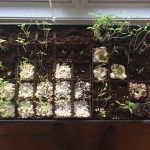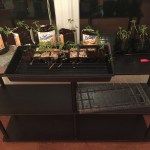
I hate that we teach education in silos. I hate the idea that some students believe what they learn in English doesn’t apply to Science. Math can’t be used in History. Health and Phys. Ed. are best left in the gym. The Arts and Math & Science just don’t mix. I wish we did a better job of getting more authentic, more cross-curricular, in our schools. I wish we did more silo-busting!
I’ve been thinking about this more than usual recently. Over the last six weeks, I’ve been working on a project. I’m getting ready to introduce Agricultural and the Internet of Things into The Innovation Lab, so I setup a play area in my kitchen to plan and experiment. I have been planning and experimenting on what getting students to use their Design Thinking skills to tackle questions like, “how might we better grow vegetables to meet the needs of a growing population” or “how might we harness technology to improve our ability to grow food” looks like in The Innovation Lab. Our goal is to get our kids thinking now about real-world problems that will likely affect them when they’re older.
6 days in hydroponic drip system 6 weeks in



In my kitchen laboratory, I started growing tomatoes and peppers hydroponically using things I would have likely thrown out, 3D printed parts from 3dponics, and ground coconut coir and/or Perlite as a growing medium. I’ll post about my experiences surrounding the grow soon, but what was a lot of fun was the building I did last night.
Last night, I used my Raspberry Pi and Cayenne to create a light meter so I could monitor in real-time, from anywhere in the world, how much light my plants are getting throughout the day. This creation has also been logging the level of light my plants are getting, every second, all day and loading the data into a Google Sheet. Check out what I’ve done with the data today (1.00 is pitch black, 0.00 is max brightness):

Lumens over a 12 hour, cloudy day on 1/18/16
Using this data over time, I can setup future experiments that tackle questions like, “how much light are my plants getting during the day,” “where am I getting the best light in my house for my plants,” or “how much light do my plants need to grow better.”
This experiment had me using knowledge you’d find in every silo in school as well as important 21st century skills like interpreting data, computer science, and finding resources and experts since Electrical Engineering isn’t my strong suit (Thanks, Twitter!).
In the classroom, if I were still an English teacher, I would tell my kids we are going to experiment with growing plants in sustainable ways to meet our research and nonfiction standards. I would then guide them in doing their research and finding experts, develop driving questions, design experiments, finding quality resources, start growing, collecting data on the amount of light plants are receiving vs. how fast they are growing using the Raspberry Pi light sensors they’ve built, and using data to answer some of their driving questions. Finally, we would wrap up by reporting and reflecting on their findings and producing something for a global audience to educate people on what my kids have learned (video, infographic, etc.) and then push it out via social media. The funny thing is, if I was a Science teacher or a Math teacher or a Health teacher – any teacher, really – I’d do the lesson almost exactly the same. I’d just change the emphasis and standards/objectives to align with what I was expected to teach.
I think this is an untapped area of educational technology: using edtech to get cross-curricular. I used the internet, social media, our 3dprinter, Raspberry Pi, and GSuite as tools to help me bust down educational silos. Without edtech, it would be much harder to get cross-curricular.
Whether we call it problem-based learning, project-based learning, passion-based learning, inquiry-based learning, authentic learning, or any other type of learning: we need to do more silo-busting. Let’s start silo-busting and letting our kids realize that learning doesn’t happen only by subject or in a vacuum. Let’s stretch ourselves as teachers, embrace technology, and find ways to get silo-busting with our kids even if we don’t have all the answers; that will just gives us the opportunity to learn together!
Until next time,
GLHF
cross-posted at Teched Up Teacher
Chris Aviles presents on education topics including gamification, technology integration, BYOD, blended learning, and the flipped classroom. Read more at Teched Up Teacher.

